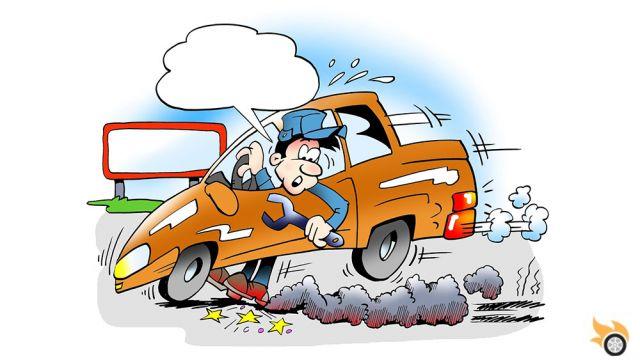
In everyday life, we are exposed to emergency situations in which we must brake abruptly to avoid an accident. However, it is important to know the consequences of sudden braking and how to act appropriately in case of an emergency on the road. In this article, we'll address all of these issues and more, so you're prepared for any eventuality.
Consequences of sudden braking
When we brake abruptly, the consequences can be diverse and affect both our vehicle and our safety. Some of the most common consequences are:
1. Premature brake wear
Sudden braking can cause premature wear of the brakes, which can result in a decrease in their effectiveness and, therefore, in an increased risk of an accident. It is important to periodically check the condition of the brakes and replace them when necessary.
2. Loss of control of the vehicle
Sudden braking may cause us to lose control of the vehicle, especially if we are driving at high speed or in adverse weather conditions. This can result in a serious traffic accident, with potentially fatal consequences.
3. Damage to the suspension and steering
Sudden braking can put a lot of stress on the vehicle's suspension and steering, which can cause damage to these systems. These damages can not only affect the performance of the vehicle, but also compromise our safety behind the wheel.
How to stop in an emergency
In an emergency on the road, it is essential to know how to brake properly to avoid an accident. Here are some tips for stopping in an emergency:
1. keep calm
The first and most important thing is to stay calm. Stay focused and avoid panicking, as this can hinder your ability to react and make the situation worse.
2. Press the brake pedal firmly but progressively
When braking, you must press the pedal firmly but progressively. Avoid sudden braking, as this can cause the wheels to lock and loss of control of the vehicle. Remember that the goal is to slow down safely.
3. Keep a safe distance
It is essential to maintain a safe distance from the vehicle that precedes you. This will give you the time and space you need to react to an emergency and brake appropriately.
Who is at fault in a rear-end collision
In a rear-end collision, it's common to wonder who is at fault. In general, the driver who rear-ends another vehicle is considered responsible for the collision. This is because all drivers are expected to maintain a safe distance and be prepared to brake in an emergency. However, there are exceptions to this rule, such as if the vehicle that was hit braked suddenly without justifiable reason.
What to do in the event of a rear-end strike
If you've suffered a rear-end strike, it's important to take the following steps:
1. Make sure you are safe
The first thing you should do is make sure you are safe. If possible, move your vehicle to a safe location and post emergency signs to warn other drivers.
2. Check for injuries
Check if there are injuries both in your vehicle and in the vehicle that hit you. If necessary, call the emergency services to provide medical assistance.
3. Exchange information with the other driver
Exchange information with the other driver, including names, phone numbers, addresses, and insurance numbers. It is also advisable to take pictures of the damage to the vehicles and obtain testimony from possible witnesses.
The importance of applying the parking brake
The handbrake is a fundamental tool to guarantee the safety of our vehicle. Operating it correctly can prevent accidents and unnecessary damage. Some of the reasons why it is important to apply the parking brake are:
1. Avoid vehicle displacement
Applying the parking brake prevents the vehicle from rolling, especially on slopes or slippery surfaces. This is especially important if we park on a steep slope, as it prevents the vehicle from rolling backwards.
2. Protect the gearbox
The parking brake also protects the vehicle's gearbox. By operating it, we prevent the gearbox from suffering unnecessary damage due to the pressure exerted by the weight of the vehicle.
3. Prevent theft
Activating the parking brake makes it difficult to steal the vehicle, since it makes it difficult to move. This can deter thieves and protect our vehicle from potential theft.
Frequently Asked Questions (FAQs)
1. What should I do if I forget to apply the parking brake?
If you forget to apply the parking brake, it is important to take steps to prevent the vehicle from rolling. First, put the vehicle in neutral and apply the brake pedal to keep it immobilized. Then safely apply the parking brake and remove your foot from the brake pedal.
2. What is the recommended safety distance?
The recommended safety distance is at least two seconds of reaction time. This means that you must maintain a distance from the vehicle ahead that allows you to come to a complete stop in an emergency. However, in adverse weather conditions or at high speeds, it is advisable to increase this distance.
Conclusion
In short, sudden braking can have negative consequences for both our vehicle and our safety. It is important to know the consequences of sudden braking and how to act appropriately in case of an emergency on the road. Remember to stay calm, brake progressively and keep a safe distance from the vehicle in front of you. Also, do not forget to apply the handbrake to ensure the safety of your vehicle. It is always better to be safe than sorry, so keep these recommendations in mind and you will be prepared for any eventuality on the road.
We hope this article has been useful to you. If you have any questions or comments, feel free to leave them below. We would love to hear your opinion!
Until next time!


























